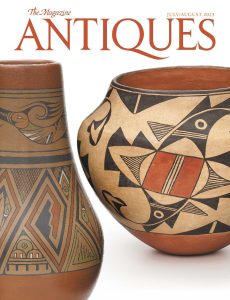
The Magazine Antiques – July-August 2023
English | 134 pages | pdf | 56.95 MB
Welcome at The Magazine Antiques July-August 2023 Issue
One of my duties as editor of this magazine is to attend numerous art and antiques fairs throughout the year. If that sounds more like a perk than a duty, I’ll have you know that I go to these events not to sightsee but to work—I look for ideas for articles; visit with exhibitors who are or might become advertisers; talk with subscribers, and gently lobby potential new ones.
All that said, I won’t pretend it’s a hardship. The opening night parties at the larger fairs can be quite entertaining. For example, the Winter Show opening gala at the Park Avenue Armory in New York is a fun and chatty event that also manifests the elegance and sophistication that make the city and its residents unique. People watching on such nights is absolutely a perk of my job.
Still, the opportunity to learn is what makes a visit to the fairs truly worthwhile. You have proximity to a huge swath of compelling art of all types—much of it, at the top-flight shows, extraordinary—in a relatively compact space, and with direct access to art professionals who are happy to share their expertise.
At a museum, you can’t just summon up a curator when you have questions—unless, I suppose, a wing of the building is named after you—but at an art fair you can get a rich education for the price of admission.
Later on in these pages you’ll hear from artist Laurene Krasny Brown on her approach to attending art and antiques fairs. In May she and I took in the New York edition of the fair presented by the European Fine Art Foundation at the Armory. TEFAF, with its preponderance of exhibitors from around the world, is perhaps the most cosmopolitan of shows on the circuit, and it was intriguing to experience the fair through Laurie’s eyes. She goes not only to learn about the art, but to learn from it—to see how other artists have worked, and perhaps discover ways their art might influence her own art making. Plus, she enjoys the people watching.
For all the splendors and fascinations they hold, art and antiques fairs like the Winter Show and TEFAF, I must confess, are not my favorites. I prefer small regional shows, where offbeat and uncategorizable art and objects can be found—and, not incidentally, at a price point I might be able to afford. Over the Memorial Day weekend I spent time at a fair I always enjoy: the Spring Antiques at Rhinebeck show in upstate New York. On this page you’ll see two strange and wonderful things that I came across, neither of which would likely have appeared in a more rarified show. One, presented by Susan Wechsler of South Road Antiques, was a massive chunk of coal—about a foot-and-a-half tall and a foot wide—that had been carved on four sides with images that included a nude, two portraits, and a tree. I’d never seen the like. (Note to the American Folk Art Museum: buy this.) The other piece was offered by Adam Irish of the Providence, Rhode Island, gallery Old as Adam. You may recall that Adam wrote for us in January 2022 about a new class of young antiques dealers who specialize in objects that are unintentionally works of art. It was such a thing that caught my eye: what I thought was a stylized metal sculpture of an owl’s head was, in fact, a late eighteenth- or early nineteenth-century swage block—a tool used by blacksmiths to shape beaten metal.
Later this summer I plan to attend two events in Manchester, New Hampshire, that are among my best loved: the show organized by the New Hampshire Antiques Dealers Association—which, though it is held in a hotel event space that features the most hideous carpet ever devised, has otherwise everything to recommend it—and the engaging Antiques in Manchester fair, held at St. Anselm’s College. Folk art and early American furniture are the focus at both of these showcases, and I always look forward to the warm spirit of humanity that surrounds such works of art. In Manchester, it’s as thick as fog. See you there.
Download from: